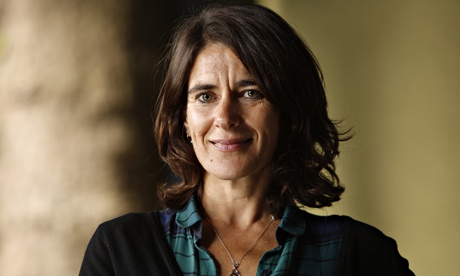The author of Hideous Kinky on her childhood memories of watching her father, Lucian Freud, paint, and how abandoning one novel led to another, about the architect Charles Rennie Mackintosh

Esther Freud at Edinburgh's international book festival earlier this month Photograph: Murdo Macleod
Esther Freud was born in London in 1963. Her first novel, Hideous Kinky (1992), was made into a film starring Kate Winslet. After publishing her second, Peerless Flats (1993), she was named one of Granta's best young British novelists. She has since written six novels, including Love Falls and Lucky Break, and teaches creative writing at the Faber Academy.
Your new novel, Mr Mac and Me, is about Charles Rennie Mackintosh's stay in Walberswick, Suffolk, during the great war, which ended in disaster when locals mistook him for a spy. What drew you to this material?
Someone told me about Mackintosh in Suffolk about 10 years ago, saying it was a good story. I thought it was a good story, but that it wasn't my story. In the end, I slowly found my way into it in the process of writing another book. There came a moment – one of life's worst, and best, moments – when I realised that everything I had been working on for the last year and a half was awful. It was a horrible realisation at the time, but it ended up leading me to this book.
What was the book you abandoned?
It was a ghost story, set in the present day, in which the ghost very occasionally chirped up with flashbacks from the past. Mackintosh was mentioned a couple of times but he was a very minor character.
Sitting down at your desk every day is an appointment with doubt; that is the nature of writing. But eventually I just had to admit that it wasn't working; there just wasn't enough happening to keep me interested. The flashbacks were sharper and more mysterious than the present day.
So I started researching the Mackintosh story and realised in the process that the present-day part had been a safety net of things I know. Once I took that away, the book began to come alive. More
Your new novel, Mr Mac and Me, is about Charles Rennie Mackintosh's stay in Walberswick, Suffolk, during the great war, which ended in disaster when locals mistook him for a spy. What drew you to this material?
Someone told me about Mackintosh in Suffolk about 10 years ago, saying it was a good story. I thought it was a good story, but that it wasn't my story. In the end, I slowly found my way into it in the process of writing another book. There came a moment – one of life's worst, and best, moments – when I realised that everything I had been working on for the last year and a half was awful. It was a horrible realisation at the time, but it ended up leading me to this book.
What was the book you abandoned?
It was a ghost story, set in the present day, in which the ghost very occasionally chirped up with flashbacks from the past. Mackintosh was mentioned a couple of times but he was a very minor character.
Sitting down at your desk every day is an appointment with doubt; that is the nature of writing. But eventually I just had to admit that it wasn't working; there just wasn't enough happening to keep me interested. The flashbacks were sharper and more mysterious than the present day.
So I started researching the Mackintosh story and realised in the process that the present-day part had been a safety net of things I know. Once I took that away, the book began to come alive. More
No comments:
Post a Comment